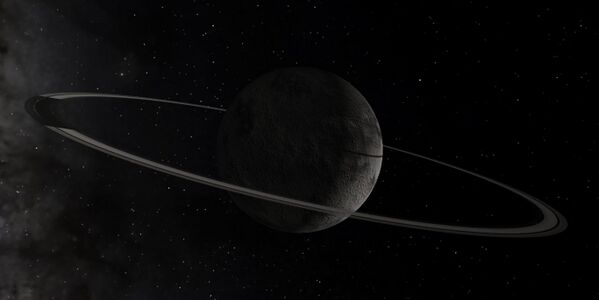Astronomy:Centaurus (spacecraft mission)
 | |
| Mission type | Flyby |
|---|---|
| Operator | NASA |
| Spacecraft properties | |
| Manufacturer | Lockheed Martin (proposed)[1] |
| Start of mission | |
| Launch date | 2026–2029 (proposed)[1] |
| Instruments | |
| Imagers, spectrometers[1] | |
Discovery program | |
Centaurus is a mission concept to flyby the centaurs 2060 Chiron and Schwassmann–Wachmann 1.[1] It was submitted in response to the NASA Discovery program call for proposals in 2019 but ultimately was not among the four missions selected for further development by NASA in February 2020.[2] If it had been selected, Centaurus would have been the first mission to attempt a flyby of a centaur.
Overview
If selected, Centaurus would have been capable of launching in any year between 2026 and 2029. The primary targets of the Centaurus mission were the centaurs 2060 Chiron and 29P/Schwassmann–Wachmann (often shortened to "SW1"). Centaurs are "escapees" from the Kuiper belt with giant planet-crossing orbits.[3] Both objects are active centaurs with perihelia within the orbit of Saturn. The Centaurus payload included imagers and spectrometers to study the surfaces, comae, and any potential rings and shepherd moons around these objects.[1] Use of solar panels would have eliminated the need for radioisotope thermoelectric generators (RTGs) or other nuclear sources.[1]
Both mission targets show evidence for rings and/or cometary activity. Chiron is the second largest known centaur, by diameter, after 10199 Chariklo. Activity was identified in the past and it may have rings.[4][5] SW1 is the most active centaur known, averaging over 7 periods of activity each year.[6] This equates to an outburst of cometary activity approximately every 50 days. Thus, there was a high likelihood of Centaurus flying by SW1 during a period of activity.
Comparison of Chiron and SW1 to 486958 Arrokoth and comet 67P/Churyumov–Gerasimenko. Pluto is shown at the bottom of the image.
Mission leadership
Centaurus is a joint proposal of the Southwest Research Institute (SwRI) and the Jet Propulsion Laboratory (JPL). The Johns Hopkins University Applied Physics Laboartory (APL) and NASA Goddard Spaceflight Center are also involved.[1] The principal investigator (PI) of the Centaurus mission is Alan Stern of SwRI in Boulder, Colorado. The Deputy PI is Kelsi Singer of SwRI.
See also
References
- ↑ 1.0 1.1 1.2 1.3 1.4 1.5 1.6 Centaurus: Exploring Centaurs and More, Messengers from the Era of Planet Formation. Kelsi N. Singer, S. Alan Stern, Daniel Stern, Anne Verbiscer, Cathy Olkin, and the Centaurus Science Team. (EPSC Abstracts Vol. 13, EPSC-DPS2019-2025-1, 2019 EPSC-DPS Joint Meeting 2019). Retrieved 6 October 2019.
- ↑ "NASA Selects Four Possible Missions to Study the Secrets of the Solar System". NASA. 13 February 2020. https://www.nasa.gov/press-release/nasa-selects-four-possible-missions-to-study-the-secrets-of-the-solar-system.
- ↑ Fernández, J.A.; Helal, M.; Gallardo, Tabaré (2018). "Dynamical evolution and end states of active and inactive Centaurs". Planetary and Space Science 158: 6–15. doi:10.1016/j.pss.2018.05.013. Bibcode: 2018P&SS..158....6F.
- ↑ Ortiz, J.L.; Duffard, R.; Pinilla-Alonso, N.; Alvarez-Candal, A.; Santos-Sanz, P.; Morales, N.; Fernández-Valenzuela, E.; Licandro, J. et al. (2015). "Possible ring material around centaur (2060) Chiron". Astronomy & Astrophysics 576: A18. doi:10.1051/0004-6361/201424461. Bibcode: 2015A&A...576A..18O.
- ↑ Ruprecht, J.D.; Bosh, A.S.; Person, M.J.; Bianco, F.B.; Fulton, B.J.; Gulbis, A.A.S; Bus, S.J.; Zangari, A.M. (2015). "29 November 2011 stellar occultation by 2060 Chiron: Symmetric jet-like features". Icarus 252: 271–276. doi:10.1016/j.icarus.2015.01.015. Bibcode: 2015Icar..252..271R.
- ↑ Trigo-Rodríguez; Melendo (2008). "A continuous follow-up of Centaurs, and dormant comets: looking for cometary activity.". European Planetary Science Congress. http://www.cosis.net/abstracts/EPSC2008/00291/EPSC2008-A-00291-1.pdf.
External links
 |









